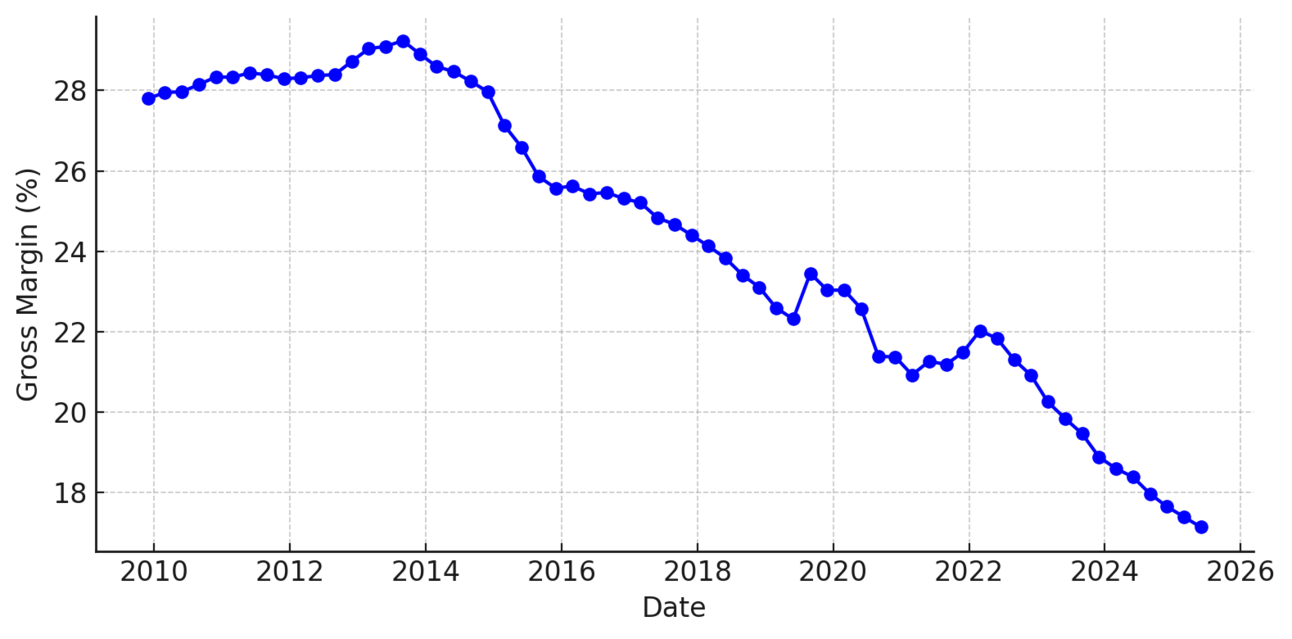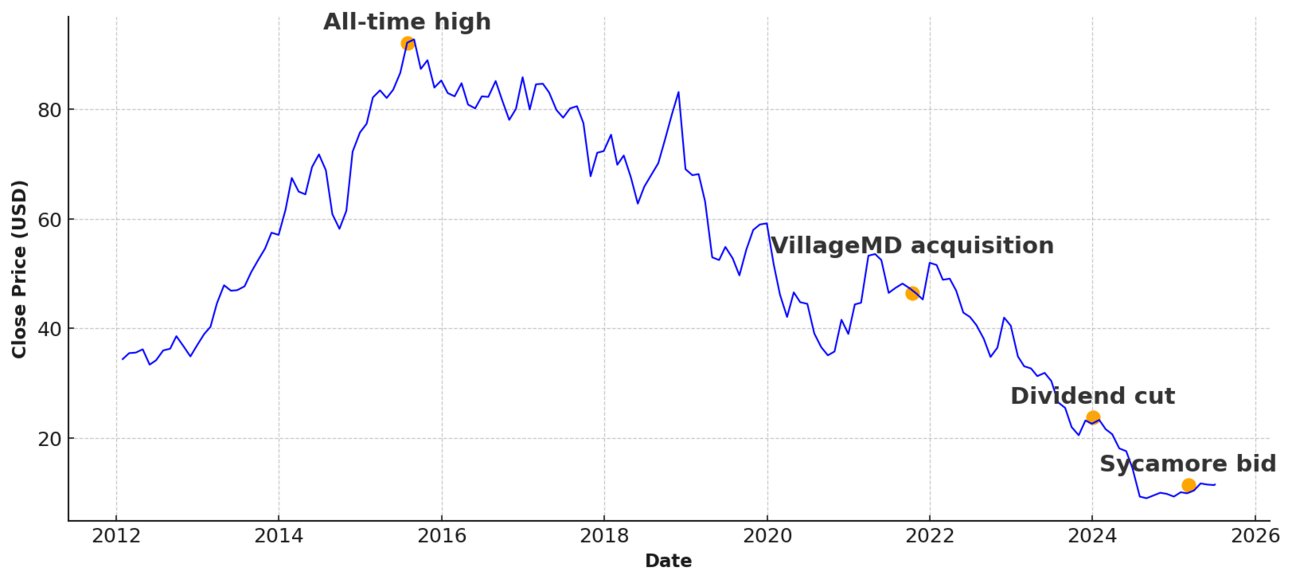- Private Equity Bros
- Posts
- $100 billion to $10 billion: How Walgreens went downhill
$100 billion to $10 billion: How Walgreens went downhill
Ever wondered how elite investment banks structure a board deck?
I have pulled together 400 real M&A presentations you can learn from — you can explore them here.
Hi there,
In March, Sycamore Partners announced its agreement to acquire Walgreens Boots Alliance (WBA) in a take-private transaction valued at $10 billion – a significant deal in the retail sector. Given the scale and strategic implications, I took a closer look at the transaction. The valuation reflects a bold approach, the deal structure appears complex, and the underlying strategy is notably direct.
Let’s dive in.
📌 Want plug-and-play financial models elite professionals use to win deals?
💰 Deal Overview
Deal Announcement | March 2025 |
Acquirer | Sycamore Partners |
Terms | $11.45 per share in cash (~$10 B equity value) plus up to $3.00 per share contingent on asset sales (largely VillageMD) |
Total EV | $23.7 B (including debt) |
Multiples | ~5.5× EBITDA, ~0.16× sales (about as low as you’ll find in retail healthcare) |
Premium | 8% over last traded price, and a theoretical 63% if every contingent payment is hit |
Financing | 83% debt / 17% equity, with asset-backed loans, receivables factoring, and a preferred slug from GoldenTree |
Closing | Targeted for Q4 2025, pending the usual approvals |
🔎 Background and Business Profile
WBA is no small operation. Founded in 1904 in Chicago, the company grew to become the second largest American pharmacy chain and now employs over 300,000 people.
Previously Walgreens, WBA was formed in 2014 after Walgreens acquired 55% of Alliance Boots (Boots UK Ltd.) resulting in 100% ownership. For those of you not familiar with Boots, think of it as the UK’s default high-street stop for day-to-day health needs — part convenience store, part pharmacy.
A few other metrics that stand out are:
Second largest pharmacy chain by revenue, with +12,000 stores in 8 countries
FY2024 revenue: $147.7B (split ~85% U.S., ~15% international)
Segment breakdown:
U.S. Retail Pharmacy: $110.3B (78% of sales)
International: $23.5B (16% of sales)
U.S. Healthcare: $8.3B (6% of sales)
Although these numbers sound impressive, the reality is that WBA has been decaying for a few years. In fact, the company had already been closing stores and announced that it would shutter up to 1,200 stores between 2025 and 2027.
So, how did this happen? Well, from the research I’ve done, there were a few failed bets and abrupt market shifts, among other factors. We unpack them in the following section.

Picture of a Walgreens Chicago back in 1962 (Source: Walgreens)
📉 How WBA started going downhill
WBA looked bullet-proof a decade ago: a US$100 billion market cap, rising store count, and reliable dividend hikes. Yet, by 2025, the equity was worth one-tenth, giving Sycamore the chance to buy the whole company for a portion of what was valued some years ago.
How did a franchise with 120-years of brand equity lose altitude so quickly? From my research, a few reasons seem evident:
1. The PBM squeeze that started slashing margins
Pharmacy-benefit managers (PBMs) are the private networks that sit between insurers and every pharmacy counter. A health plan hires a PBM to decide which drugs make the formulary, process each claim in real-time, collect rebates from manufacturers and, crucially, tell the drugstore what it will be paid for dispensing the script.
That said, if WBA, like any other competitor, is not happy with the conditions proposed by a certain PBM, it can refuse to work with them. However, this will mean that there will be less sales, but assuming that there are other PBMs to do business with, WBA can compensate for those lost opportunities.
Until a few years back, it seemed that that’s how WBA operated. However, that eventually changed when some of these PBMs started growing their market share. What I mean by this is: there were several PBM acquisitions in recent years and now the market is pretty much dominated by only three companies which have nearly 80% of the market share: CVS Caremark, Express Scripts and Optum Rx.
This means that, whereas WBA could refuse doing business with a specific PBM before, now the repercussions are massively considering that they own a substantial share of the market. As a result, the power now shifted to the PBMs leading WBA to (roughly) accept whatever conditions are imposed. In practical terms, the PBMs now have more control over pricing, leading to a margin compression for WBA.

WBA Gross Profit Margin (Data Source: Macrotrends)
2. Competitors capturing the spotlight and redefining the sector
As Walgreens grappled with a changing industry, its main rivals seized the initiative, not just by growing bigger, but by fundamentally reshaping what it means to be a pharmacy leader. CVS, for instance, transformed itself from a traditional drugstore into a vertically integrated healthcare powerhouse — merging retail, insurance, and pharmacy benefits under one roof — having completed a series of acquisitions in recent years which included the $70 billion acquisition of Aetna.
This allowed CVS to launch high-profile health hubs, roll out digital wellness programs, and become a go-to partner for employers and insurers seeking comprehensive solutions. Meanwhile, Express Scripts and Optum Rx built reputations as innovative, data-driven managers of prescription plans, winning major contracts and earning recognition as industry standard-bearers.
Put simply, WBA’s rivals kept expanding while WBA was sliding, and now its share of U.S. prescription spend sits near 14.7% vs. CVS’s 25.7% — a gap that has widened steadily since 2018, as Caremark and Aetna funnel their own members back to CVS locations. Optum can do the same inside UnitedHealth. The result: Walgreens increasingly accepts thinner reimbursements just to stay inside preferred networks, instead of dictating terms as it once did.
3. Capital misfires under pressure
Walgreens paid roughly $15 billion in 2014 to take full control of Boots, promising global purchasing scale and steady earnings accretion. A decade on, most of the touted synergies have failed to translate into durable margin lift, and the transaction remains a drag on return on invested capital.
Management’s next pivot — acquiring a majority stake in VillageMD — proved even more costly. A $5.8 billion goodwill impairment in March 2024 and the closure of about 140 clinics underscored fundamental flaws in the concept: reimbursement resets, slower physician-panel growth, and the physical limits of co-locating full-service practices inside legacy drugstores.
Free cash flow weakened further as the group funded health-services capex, opioid settlements, and an ageing lease portfolio; the plan now contemplates shutting as many as 1,200 U.S. stores to stem losses.
With the equity trading at a fraction of its 2015 peak, Sycamore’s $10 billion take-private offer effectively equals what Walgreens has already sunk into VillageMD.

WBA Historical Price Evolution (Data Source: Yahoo Finance)
📅 So, who is Sycamore and what’s the plan?
Sycamore Partners is not a household name, yet its fingerprints are on much of U.S. retail. Founded by ex-Golden Gate Capital partner Stefan Kaluzny, the firm manages roughly $11 billion and specializes in taking unfashionable consumer brands private, leveraging them hard and selling the pieces later.
As noted on the company presentation from the original deal materials, Sycamore typical playbook involves “seeking out break-up candidates, being willing to stretch leverage, and being comfortable operating in bankruptcy.” Knowing with certainty what they will do to WBA, only with a crystal ball. Nevertheless, we can infer some possibilities by analysing the deal materials.
1. Monetizing Healthcare Assets: The VillageMD Play
Sycamore’s first and most explicit move is to unlock value from WBA’s healthcare bets — most notably VillageMD, Summit Health, and CityMD. The deal structure itself tells the story: shareholders get a “Divested Asset Proceed Right” (DAP Right), which entitles them to up to $3 per share from the future sale of these assets.
This is classic PE: carve out the non-core, loss-making healthcare units and sell them off to strategic buyers or other private equity funds. The DAP Right mechanism indeed incentivizes a swift process, and the proceeds will help de-lever the highly financed deal.
2. Boots UK: Preparing for a Sale or Spin-Off
Next up is Boots, the iconic UK pharmacy and beauty chain. While Boots remains a household name in Britain, it’s not core to Sycamore’s US-focused retail ambitions. The deal’s financing structure reportedly isolates Boots with its own debt package — often a sign that a business is being prepped for a standalone future.
WBA already tried to sell Boots in 2022, but couldn’t get the price it wanted. Sycamore, with more flexibility as a private owner, is likely to revisit a sale or even a public spin-off once market conditions improve. Expect aggressive cost cuts and a focus on shoring up Boots’ profitability to maximize its sale value.
3. Streamlining US Retail: Store Closures and Operational Overhaul
The core Walgreens US retail business is bloated, with too many underperforming stores and operational inefficiencies. WBA had already announced plans to shutter underperforming stores before the deal — and Sycamore will likely accelerate this — targeting both Walgreens and Boots locations.
Expect a ruthless focus on margin expansion — think renegotiating supplier contracts, shrinking corporate overhead, and investing in digital upgrades to modernize the in-store experience. The aim? Drive up EBITDA, generate cash flow, and set the stage for a future sale or IPO of the leaner, more profitable US retail business.
4. The Private Equity Exit: Breakup, Repackage, Sell
Ultimately, Sycamore’s endgame is classic private equity: break up the conglomerate, sell off the parts, and pocket the arbitrage. By taking WBA private, Sycamore gets the freedom to make tough decisions without Wall Street scrutiny — whether that’s asset sales, deep cost cuts, or even bankruptcy for underperforming units (a tactic not unheard of in their portfolio).
Once the dust settles, expect Sycamore to repackage the remaining businesses — likely a streamlined US pharmacy chain — and look for a lucrative exit, either via a strategic sale or a return to public markets.
If you’re enjoying these mid-week editions, let me know what you’d like to see next — investor profiles, firm histories, or deep-dives on strategic shifts. I’m always open to ideas.
Until next time,
PE Bro
P.S. Was this forwarded to you? Subscribe here.
Did you enjoy today's edition? |
Looking to go a bit deeper?
Here are 3 things that might be worth your time:
Disclaimer: This overview is based on publicly available sources and represents my personal view only. While accuracy is a priority, not all details are independently verified. This is not an official statement from WBA nor Sycamore Partners or any of its affiliates.
A Message from Today’s Sponsors
Investment picks returning 200%+
AIR Insiders get weekly expert investment picks and exclusive offers and perks from leading private market investing tools and platforms. So if you’re looking to invest in private markets like real estate, private credit, pre-IPO venture or crypto, the time to join FOR FREE is now.
These Are The Rolls-Royce Of Hearing Aids (And Under $100)
Oricle Hearing gives you crystal-clear sound, wireless charging, and all-day battery life for under $100. No doctor visits, no crazy prices—just amazing hearing at an unbeatable deal.
Discover how these affordable hearing aids are changing the lives of people everyday.

